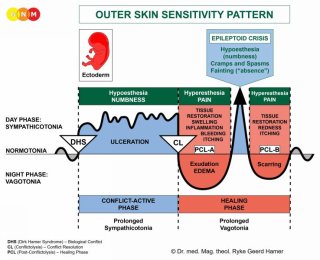LARYNX
|
DEVELOPMENT AND FUNCTION OF THE LARYNGEAL MUCOSA: The larynx is a tube-shaped organ that connects the pharynx with the trachea. The larynx is part of the respiratory tract and involved in talking and swallowing. The vocal cords, located within the larynx, participate in the production of sound (this is why the larynx is colloquially called the “voice box”). The mucosa of the larynx and vocal cords consists of squamous epithelium, originates from the ectoderm and is therefore controlled from the cerebral cortex.
BIOLOGICAL CONFLICT: The biological conflict linked to the mucosa of the larynx and vocal cords is a female scare-fright conflict or a male territorial fear conflict, depending on a person’s gender, laterality, and hormone status (see also Flying Constellation). A scare-fright conflict is the female response to unforeseen danger while a territorial fear conflict is the male response to a territorial threat. The conflict can be triggered by any frightening experience.
CONFLICT-ACTIVE PHASE: ulceration in the laryngeal mucosa proportional to the degree and duration of conflict activity. The biological purpose of the cell loss is to widen the larynx to allow more air-intake to be better able to cope with the fright.
HEALING PHASE: During the first part of the healing phase (PCL-A)the tissue loss is replenished through cell proliferation. In conventional medicine, the cell increase is diagnosed as a laryngeal cancer or “throat cancer”. Based on the knowledge of GNM, the new cells cannot be regarded as “cancer cells” since the cell increase is, in reality, a replenishing process.
Healing symptoms are pain due to the swelling caused by the edema (fluid accumulation), difficulties swallowing, coughing, and a hoarse voice or even a complete loss of voice since the vocal cords are affected as well. Depending on the intensity of the conflict, the symptoms range from mild to severe. With an inflammation the condition is called laryngitis, typically accompanied by fever.
After the Epileptoid Crisis, the swelling subsides and in PCL-B the organ slowly returns to its normal function.
What is termed “diphtheria” is, in GNM terms, a healing process in the larynx with the SYNDROME. The concurrent water retention enlarges the swelling and increases the pain; breathing also becomes more difficult.
Vocal cord polyps are hardened squamous epithelial warts that develop as a result of repetitive healing due to conflict relapses. So-called “Singer’s Nodes” are vocal cord nodules caused by injury to the vocal cords because of voice abuse (singing, yelling). In this case, the nodules form as a consequence of the recurring tissue repair - without a DHS.
|
|
DEVELOPMENT AND FUNCTION OF THE LARYNGEAL MUSCLES: The larynx consists of an epithelial mucosa and a layer of smooth and striated muscles. The main function of the laryngeal muscles is to regulate the expansion and contraction of the glottis, the vocal apparatus of the larynx with the two vocal cords. The laryngeal muscles keep the glottis open during respiration and more closed during vocalization. The striated part of the laryngeal muscles originates from the new mesoderm and is controlled from the cerebral medulla and the motor cortex. NOTE: The smooth laryngeal muscles are of endodermal origin and controlled from the midbrain.
BIOLOGICAL CONFLICT: The biological conflict linked to the laryngeal muscles is the same as for the larynx mucosa, namely a female scare-fright conflict or a male territorial fear conflict, depending on a person’s gender, laterality, and hormone status (see also Laryngeal Asthma Constellation, Bronchial Asthma Constellation). The distinguishing aspect of the conflict related to the muscle tissue is the additional distress of “not being able to escape”, “not being able to (re)act”, feeling “rooted to the ground” (petrified), or “feeling stuck” (see skeletal muscles).
CONFLICT-ACTIVE PHASE: cell loss (necrosis) of laryngeal muscle tissue (controlled from the cerebral medulla) and, proportional to the degree of conflict activity, increasing paralysis of the laryngeal muscles (controlled from the motor cortex). The paralysis causes breathing difficulties, explicitly, difficulties exhaling – inhaling is extended because of the reduced function of the laryngeal muscles that control exhaling. If the vocal cords are affected, this causes a voice changes (voice break) or, with an intense conflict, a vocal cord paralysis with an inability to produce sound.
HEALING PHASE: During the healing phase the laryngeal muscles are reconstructed. The paralysis reaches into PCL-A. The Epileptoid Crisis presents as coughing fits with spasms and convulsions of the larynx, equivalent to a focal seizure. A cough that comes from the larynx sounds like “barking” (the expression “kennel cough” points to a scare-fright conflict suffered by animals in the kennel). In PCL-B, the function of the laryngeal muscles returns to normal.
What is termed “spasmodic dysphonia” indicates that the laryngeal muscles as well as the larynx mucosa are in healing. Whooping cough (pertussis) is also such a combined process (see also whooping cough related to the bronchial muscles).
Recurring symptoms or an “allergy cough” are brought on by conflict relapses triggered by setting on a track that was established when the original conflict took place (see allergies).
LARYNGEAL ASTHMA involves two Biological Special Programs (see also bronchial asthma)
In this case, the person is in a Laryngeal Asthma Constellation, also throughout the Epileptoid Crisis which is a temporary reactivation of the conflict-active phase.
Chronic laryngeal asthma attacks indicate that the related scare-fright conflict has not been completely resolved. In conventional medicine, recurring asthma attacks are usually associated with an “allergy”.
Hence, the laryngeal asthma attack involves both the striated and smooth laryngeal muscles. The Epileptoid Crisis of the striated laryngeal muscles presents as laryngeal spasms and convulsions. The Epi-Crisis of the smooth muscles presents as a hyper-peristalsis similar to an intestinal colic. Hence, BOTH the smooth and striated laryngeal muscles take part in the asthma crisis. The same applies to the bronchial asthma attack; in this case, the smooth and striated bronchial muscles are involved.
| ||||||||||||||||||||||||||||||||||||||||||||||||||||













